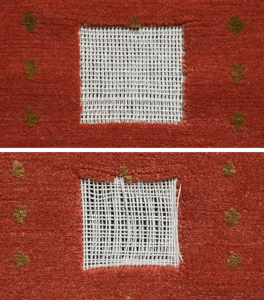Offering the highest standards of responsible design and workmanship, New Moon strives to carry forward the thread of one of mankind’s oldest art forms without being merely imitative and without compromising quality or social responsibility.

CONSTRUCTION
Unlike the vast preponderance of rugs now coming from Nepal, New Moon continues the age-old traditions of true Tibetan weaving– no shortcuts, no compromises. In New Moon’s ‘crossed’ weaving, each successive row of knots is locked into place by pulling alternate rows of warps forward on the loom, passing the weft between the separated warps and pounding down tightly. This is more difficult, more time-consuming and more expensive. But it is also the only way to make a lasting rug. It forms an interlocked foundation, over and under like a tennis racket. These are the true ‘lifetime rugs’, lasting for generations. ‘Uncrossed’ rugs are literally ‘hollow.’ There is nothing holding their foundations together.

KNOT COUNT
The knot count states how many individual knots of wool are found in one square inch of a handmade rug. In essence, the knot count defines the rug’s fineness. A higher knot count allows for more detail in the design while also providing a finer rug texture than that of a lower knot count. You can physically feel the fineness of a rug when you grab it and try to bend it. A Tibetan rug with a very high knot count and crossed foundation will bend quite easily. You can actually grab a section of a finer rug and crumple into one hand much like you would with a towel. You can be confident that the knot count of a New Moon rug is accurate. Unlike many others, we do not exaggerate the number of knots so you can be certain that you will find 100 knots per square inch in one of our 100 knot rugs.

DENSITY OF PACKAGING
After the weavers finish weaving a row of knots, the alternate warp shed is pulled forward and the weft is passed through, then pounded down hard on the row of knots. This takes time and is hard work but it is essential for strengthening the foundation of the rug. New Moon weavers pack each rug very tightly in order to strengthen the rug and offer the durability necessary for it to last generations.

COLOR TWEEDING
Tweeding creates a complexity of color that gives a rug depth and vibrancy. The process of tweeding is labor-intensive and time-consuming. The dyed wool, which has been spun together with three plies of wool into miles of twisted strands, must all be pulled apart. Then one ply of another shade is placed together with two of the original-color plies. The combination of plies is then once again twisted together. The majority of New Moon rugs are enhanced by this technique but it is a process that takes much longer to do.


NUMBER OF COLORS
New Moon offers an unprecedented number of colors in its rug designs. Most Tibetan rugs might have an average of 5 colors in a rug whereas New Moon averages from 12 to 25, with the most complicated pieces having up to 126 color combinations.

NO STRONG CHEMICAL WASHES
Strong chemical washes strip the wool of its natural lanolin. The wash creates an immediate shine but only at the expense of the wool, which has been stripped of its natural lanolin and weakened by the strong chemicals. New Moon rugs are not washed with harsh chemicals. Rather, their beautiful shine naturally reveals itself after being polished through the exposure to light, air and, of course, passing feet!
THE FINEST MATERIALS


TIBETAN WOOL
New Moon rugs are made with the highest quality of Tibetan wool available. This wool comes from the sheep of the Tibetan plateau at an altitude of 14,000 ft. Long fibers, high lanolin content and the unique physical structure of Tibetan wool makes it the ideal choice for rug weaving.

COMPLEXITY OF DESIGN
Due to the complexity of the designs, New Moon weavers are the most highly skilled weavers in Nepal, as well as the highest paid. Because of the skill and time it takes to weave a New Moon rug, weavers are paid more and thus are not forced to work longer hours to make a fair wage.

HAND DRAWN GRAPHS
Instead of the computer-generated graphs used by most producers, which make for uniform, mechanical-looking rugs, New Moon creates their graphs by hand. Highly skilled artists translate original paintings into knot by knot graphs, which accounts for the “one-off” beauty and vitality of New Moon rugs.

CROSSED WEAVING
At the present time almost all rugs coming out of Nepal, in all knot counts, are employing a shortcut. They are not ‘crossing’ the warps between rows of knots. This creates an unconnected foundation. These rugs do not have the same strong foundation of a crossed-woven rug. To all appearances a rug can be a sophisticated-looking wool and silk, 100 knot, supple to the touch—and still be “uncrossed” weaving. Because on the surface they appear the same, the customer is unable to tell the different between a ‘crossed’ and ‘uncrossed’ rug.
ALL New Moon™ Rugs are created using crossed weaving, so you get the best quality possible and peace of mind that your New Moon™ Rug will last.
